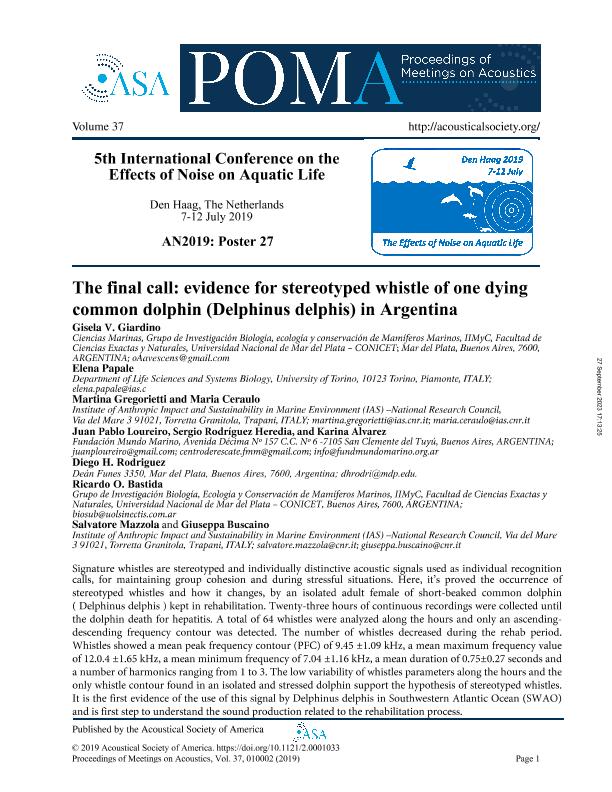Evento
The final call: evidence for signature whistle of dying common dolphin in Argentina (South America)
Giardino, Gisela Vanina ; Papale, Elena; Gregorietti, Martina; Ceraulo, Maria; Loureiro, Juán Pablo; Rodriguez Heredia, Sergio; Alvarez, Karina; Rodriguez, Diego Horacio
; Papale, Elena; Gregorietti, Martina; Ceraulo, Maria; Loureiro, Juán Pablo; Rodriguez Heredia, Sergio; Alvarez, Karina; Rodriguez, Diego Horacio ; Mazzola, Salvatore; Buscaino, Giuseppa
; Mazzola, Salvatore; Buscaino, Giuseppa
 ; Papale, Elena; Gregorietti, Martina; Ceraulo, Maria; Loureiro, Juán Pablo; Rodriguez Heredia, Sergio; Alvarez, Karina; Rodriguez, Diego Horacio
; Papale, Elena; Gregorietti, Martina; Ceraulo, Maria; Loureiro, Juán Pablo; Rodriguez Heredia, Sergio; Alvarez, Karina; Rodriguez, Diego Horacio ; Mazzola, Salvatore; Buscaino, Giuseppa
; Mazzola, Salvatore; Buscaino, Giuseppa
Tipo del evento:
Conferencia
Nombre del evento:
5th International Conference on The Effects of Noise on Aquatic Life
Fecha del evento:
07/07/2019
Institución Organizadora:
Acoustical Society of America;
Título del Libro:
Book of Abstracts: 5th International Conference on The Effects of Noise on Aquatic Life
Editorial:
Acoustical Society of America
Idioma:
Inglés
Clasificación temática:
Resumen
Signature whistles are stereotyped and individually distinctive acoustic signals emitted by T.truncatus in isolated captive conditions. They are used as individual recognition signals, for maintaining group cohesion and during stressful situations (Janik and Sayigh, 2010). However, little information was reported for other species (reviewed in Janik and Sayigh, 2013). Here, we tested the hypothesis of the occurrence of signature whistles in an isolated short-beaked common dolphin (Delphinus delphis) kept in a rehab circular tank (13m diameter, 1.35m deep) at Mundo Marino Aquarium (San Clemente del Tuyú). The dolphin, an adult female, was found ashore in Villa Gesell, Argentina, on 19th January 2019. During its maintaining, a hydrophone (model Benthowave BII-7017) with a flat sensitivity response of -174.5 (± 2) dB re V/µPa from 0.1 to 100 kHz connected to digital analogical converter C5535 DSP (TMS320C5535), was deployed in the tank. Twenty-three hours of continuous recordings were collected, starting after 12 hours from the beginning of the dolphin´s rehab until their death for hepatitis. Data were visually screened and the number of whistles was noted. Six parameters (peak, maximum and minimum frequencies, duration, frequency contour and the number of harmonics) were measured from the recorded whistles by using Raven Pro (Cornell University). A total of 59 whistles were analyzed and only one type of frequency contour was detected (ascending-descending). They showed an averaged peak frequency of 9. 04 ±2.33kHz; an averaged maximum frequency value of 13.28 ±1.81 and a minimum of kHz; a 5.99 ±1.58; the average duration was 0.72 ±0.29 seconds and harmonic´s number ranging from 1 to 4. The CV values of all parameters were lower than 0.4. The low variability of whistles parameters and the only whistle contour found in an isolated and stressed dolphin support the hypothesis that they produce signature whistles. It is the first evidence of the use of this signal in D.delphis in Southwester Ocean. Dolphins produce many non-stereotyped whistles but detecting the presence of signature whistles can provide us new info on socio-behavioral aspects and on the use of vocalizations. Our work is the first step to understanding Latin American common dolphin sound production, which the majority of the ecological aspects are unknown.
Palabras clave:
Delphinus delphis
,
Sonido
,
Rehabilitación
,
Argentina
Archivos asociados
Licencia
Identificadores
Colecciones
Eventos(IIMYC)
Eventos de INSTITUTO DE INVESTIGACIONES MARINAS Y COSTERAS
Eventos de INSTITUTO DE INVESTIGACIONES MARINAS Y COSTERAS
Citación
The final call: evidence for signature whistle of dying common dolphin in Argentina (South America); 5th International Conference on The Effects of Noise on Aquatic Life; Países Bajos; 2019; 1-9
Compartir



